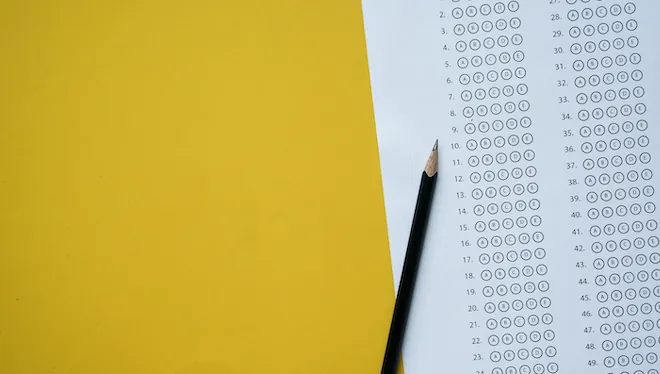
Fewer schools are requiring SAT or ACT test scores for admission, and fewer applicants are submitting them
Where can you find the business school students who scored best on the Scholastic Aptitude Test in 2021?
And where can you find the students who scored best last year on the American College Test?
Turns out you can find them at the same school: New York University’s Stern School of Business.
NYU Stern led 93 other schools in Poets&Quants‘ 2022 ranking of undergraduate business schools in both SAT and ACT score averages, with a 1531 average in the former and a 35 average in the latter. Only one other B-school in our ranking reported an average SAT score above 1500, and only three schools had ACT averages of 34 or more.
But as much as the Stern School is proud of those marks, its admits and students are about more than just test-taking aptitude, says Robert Whitelaw, vice dean of the undergraduate college at NYU Stern. High score averages, he says, shouldn’t scare off potential applicants.
“NYU Stern attracts talented, multidimensional students from all around the globe, and the NYU Admissions team has a really difficult job!” Whitelaw tells Poets&Quants. “But the most important takeaway for potential applicants to Stern is that our approach to admissions is holistic and looks at not only academic potential and demonstrated dedication to extracurriculars, but also who they are and why they want to study business in New York City.”
ONE SCHOOL’S SAT AVERAGE JUMPED 116 POINTS IN 1 YEAR

NYU Stern’s Robert Whitelaw: Stern is a leader in “preparing students to thrive in the face of constant change, regardless of their major, career pursuits, or background”
Standardized testing is changing — while, simultaneously, becoming a less important part of the college admissions process. Many universities and even entire school systems are eliminating SAT or ACT requirements for admission. But because many still require a score, and because many students still submit them, Poets&Quants asks participating schools to report SAT and ACT scores as well as the percentage of the incoming class that reported those scores as part of the data collection process for our annual ranking of Best Undergraduate Business Schools. It plays a role in our methodology — but more importantly, it’s useful information for future B-school students.
After NYU Stern, of 94 schools in our 2022 ranking, the top schools in SAT average are Stern (ranked No. 7 overall) at 1531, Washington University in St. Louis Olin Business School at 1523, Carnegie Mellon Tepper School of Business at 1497, the University of Pennsylvania’s Wharton School at 1497, and the University of Southern California Marshall School of Business at 1479. The lowest reported score, and the only one in the ranking that is sub-1000, was at the University of Wisconsin-Milwaukee Lubar School of Business, which reported an average score of 971.
Last year, Washington Olin led all schools with an SAT average of 1511, followed by NYU Stern at 1507 and Wharton at 1504. Last year’s lowest score was at the University of Akron, which reported a 981. A score of 1500 to 1550 puts students in the 98th to 99th percentile, as the test is on a 1600 scale. This year the number of schools reporting a score of 1400 or above is 22, up from 17 last year. Of those 22, five climbed there from 2020 to 2021.
The biggest gain in average SAT score occurred at the Saunders College of Business at Rochester Institute of Technology, which grew its class score 116 points, to 1308; other notable increases occurred at the University of the Pacific (+64 to 1205), Southern Methodist University Cox School of Business (+58 to 1457), the University of Miami Herbert Business School (+50 to 1379), and Hofstra University Zarb School of Business (+50 to 1256). The biggest drop-offs happened at the University of Washington Foster School of Business, which slimmed down its class SAT average by 93 points to 1319; also significant: the University of Houston Bauer College of Business (-72 to 1234) and the University of Texas at Arlington College of Business (-68 to 1022).
In all, 35 schools saw double-digit gains, and 21 saw double-digit drop-offs. The total average score (for 88 schools) was 1286.6, up slightly from 1283 last year and good enough to fit between the 84th and 85th percentile of all SAT takers. In the top 10 of P&Q‘s ranking, the average score was 1463.2, up about 11 points from 1452.3 in 2020, and between the 96th and 97th percentiles of all SAT takers.
FAR FEWER REPORT SAT SCORES TO GET INTO B-SCHOOL
Reporting percentages tell an interesting story. In a word, they are sinking — because of relaxed admissions requirements amid Covid, certainly, but also because of schools moving away from over-reliance on entrance exams, in favor of what Robert Whitelaw calls a more “holistic” approach to admissions. The number of schools with 50% or more reporting SAT scores dropped by more than half, to 25 from 56 last year, while the number above 60% dropped to 13 from 50. In 2020, 35 schools had 70% or more applicants submit SAT scores; in 2021, that number was six. And zero schools — none — had 90% submissions, whereas in 2020 five did.
Forty-one schools had below 30% SAT submissions in 2021, and another 23 below 20%. The highest rate of submission was at Florida International University (86%); the lowest, at the University of Wisconsin-Milwaukee Lubar School of Business (1%).
Of 74 schools with enough data for comparison, 66 reported SAT reporting numbers declining, and 51 saw them decline by double digits. Only seven schools reported increases. The biggest declines were at Rutgers Newark (-74 percentage points to 21%), the University of Massachusetts-Amherst Isenberg School of Management (-64 to 24.8%), and Rochester Saunders (-64 to 23.3%). Other notables: Minnesota Carlson cut its percentage in half, from 64% to 32%; Fordham Gabelli by more than half, from 75.39% to 31.65; CMU Tepper dropped by 34 points, to 41.7%; the University of Pittsburgh fell 36 points to 46%; Drexel LeBow lost 51 points, to 35%; Delaware Lerner fell 48 to 30.5%; Elon Love dropped 50 to 28%; New Hampshire Paul -48 to 29%; Marian Byrum -59.4 to 15.6%; Oregon State -49.8 to 24.2%; and Northern Illinois -56.4 to 17%.
And the biggest gain? That happened at the University of Illinois at Urbana-Champaign’s Gies College of Business, which added 36.7 points to 59.1%.
In the top 10, the average decline among seven schools was 13.3 points. Two elite schools, however, bucked the trend, with Virginia McIntire up 15 points to 77%, and Villanova up 2.39 points to 63%.
ACT: REPORTING NUMBERS PLUMMET
Last year, NYU Stern and Wharton shared the top ACT score: 34. This year Stern inched up a point to lead all schools at 35, followed by Wharton and Carnegie Mellon Tepper at 34, Washington-St. Louis Olin at 33.8, and four schools at 33: Michigan Ross, Notre Dame Mendoza, Villanova, and Boston Questrom. In all, 26 schools reported ACT averages of 30 or more, down from 30 schools last year. The average score for top-10 schools did not change much, inching up to 33.17 at eight schools that provided sufficient data for comparison, from 33.01 last year (also eight schools).
Thirty schools across the ranking reported gains in their class score, and 28 reported declines (10 schools were even). Mostly the gains and losses were minor: The biggest gains came at Iowa State Ivy, up 3.3 points to 23.3, and American Kogod, up 2.3 points to 29.3; the biggest drop-off was at St. John's University Tobin College of Business, which lost 9 points on its average (to 27), and at Washington Foster, which slimmed down by 2.7 points to 28.3.
The real news, as with SATs, is in the reporting percentages. Of the 68 schools for which we had enough data to compare year-to-year, nearly every one — 63 — saw declines in the percentage of applicants submitting ACT scores, with only three gaining and two more even. Notable drop-offs include Minnesota Carlson, which saw its reporting numbers cut by more than half, to 41% from about 93%, and the Chaifetz School of Business at Saint Louis University, which dropped to 31% from 81.5%. Among the top schools, NYU Stern dropped from 33% to 15%, Tepper from 31.3% to 16.6%, Ross from 59.2% to 40%, and Olin from 69% to 36%. Wharton, notably, stayed even at 33%. Of the three schools reporting an increase, the only one of significance was at Illinois Gies, which reported a gain of 38.7 points to 59.1%.
'THE ONE CONSTANT WE CAN ABSOLUTELY COUNT ON IS CHANGE'
What draws the best-testing students to the Stern School at NYU?
"Our goal," Robert Whitelaw says, "is to enroll a diverse and well-rounded class with a passion for business, in all of its many dimensions. And this goal, and the breadth of our students’ interests, is reflected in the range of degree programs we offer — the BS in Business, with concentrations in traditional areas such as Finance and newer ones such as Sustainable Business; the BS in Business and Political Economy; and, our newest offering, the BS in Business, Technology and Entrepreneurship."
Compared to its peer schools, NYU Stern is the undisputed leader in "preparing students to thrive in the face of constant change," he says, "regardless of their major, career pursuits, or background."
Whitelaw adds: "There really is no blueprint for an NYU Stern student. We welcome students from all over the world who have a variety of interests, those who have big ideas about their future and those who are just beginning to figure out who they are and what they want out of life. Our job is to meet them where they are and foster a community where everyone can grow and excel."
NYU Stern — a top undergraduate and MBA school — offers a high value proposition for students’ future careers, Whitelaw says, even, perhaps especially, in a time of constant disruption and change.
"The one constant we can absolutely count on is change, and our intention is to teach and empower students to thrive in a rapidly changing world," Whitelaw says. "Employers tell us that they are looking for talent that is agile, comfortable with ambiguity, and able to problem solve and innovate under these conditions, both independently and in teams. The Stern Undergraduate College experience is designed to immerse students in a rich educational experience that integrates business with liberal arts, social impact, culture, and more. We create a learning environment that encourages and supports students to experiment, explore, collaborate, reflect, and develop.
"Whether it’s in New York City or at an NYU campus around the world, or through clubs, coursework, experiential learning projects, or research opportunities, students can carve out a path that aligns with their values, ambitions, and goals."
See the next pages for complete tables of ACT and SAT scores at the 94 schools in Poets&Quants' 2022 business school ranking.
AND DON'T MISS:
WHARTON AGAIN TOPS POETS&QUANTS' BEST UNDERGRADUATE BUSINESS SCHOOL RANKINGS
ACCEPTANCE RATES AT THE TOP U.S. UNDERGRADUATE BUSINESS SCHOOLS
HIGH SCHOOL GPAs AT THE TOP BUSINESS SCHOOLS
TOTAL COST FOR A TOP-RANKED BUSINESS DEGREE
STARTING SALARIES & BONUSES FOR BUSINESS MAJORS IN 2021
2022 REPORT CARD: HOW ALUMS GRADE THEIR B-SCHOOL EXPERIENCE
THE METHODOLOGY BEHIND P&Q'S 2022 UNDERGRADUATE RANKING
BUSINESS SCHOOLS WITH THE HIGHEST PERCENTAGE OF MINORITY & INTERNATIONAL STUDENTS
IN SEARCH OF GENDER PARITY: BUSINESS SCHOOLS WITH THE HIGHEST PERCENTAGE OF WOMEN











Questions about this article? Email us or leave a comment below.